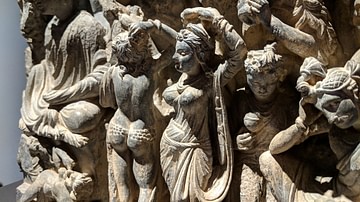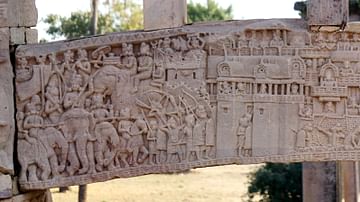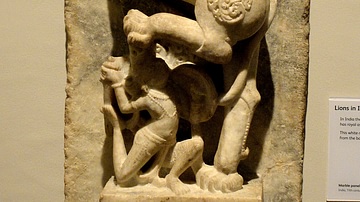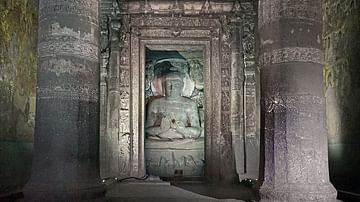Illustration
This sculpture represents the Buddha on the verge of enlightenment responding to the challenge of the demon Mara. Mara, who profits from chaos and suffering in the world, questioned the Buddha's right to become enlightened. Disturbed from his meditation, the Buddha responded by reaching out this right hand to touch the earth with his fingertips, calling upon the Earth to be his witness. The Earth goddess rose up and wrung her hair, unleashing a flood that washed Mara and his demon army away. This sculpture is made of Chlorite and dates from the 10-11th century CE. It was likely made in West Bengal or Bihar, India during the Pala period (730–1197 CE). (Iris & B. Gerald Cantor Center for Visual Arts at Stanford University, Stanford, California)
About the Author
Cite This Work
APA Style
Wiener, J. B. (2018, January 16). Buddha in the Attitude of the Victory over Mara. World History Encyclopedia. Retrieved from https://www.worldhistory.org/image/7928/buddha-in-the-attitude-of-the-victory-over-mara/
Chicago Style
Wiener, James Blake. "Buddha in the Attitude of the Victory over Mara." World History Encyclopedia. Last modified January 16, 2018. https://www.worldhistory.org/image/7928/buddha-in-the-attitude-of-the-victory-over-mara/.
MLA Style
Wiener, James Blake. "Buddha in the Attitude of the Victory over Mara." World History Encyclopedia. World History Encyclopedia, 16 Jan 2018, https://www.worldhistory.org/image/7928/buddha-in-the-attitude-of-the-victory-over-mara/. Web. 24 Apr 2025.








